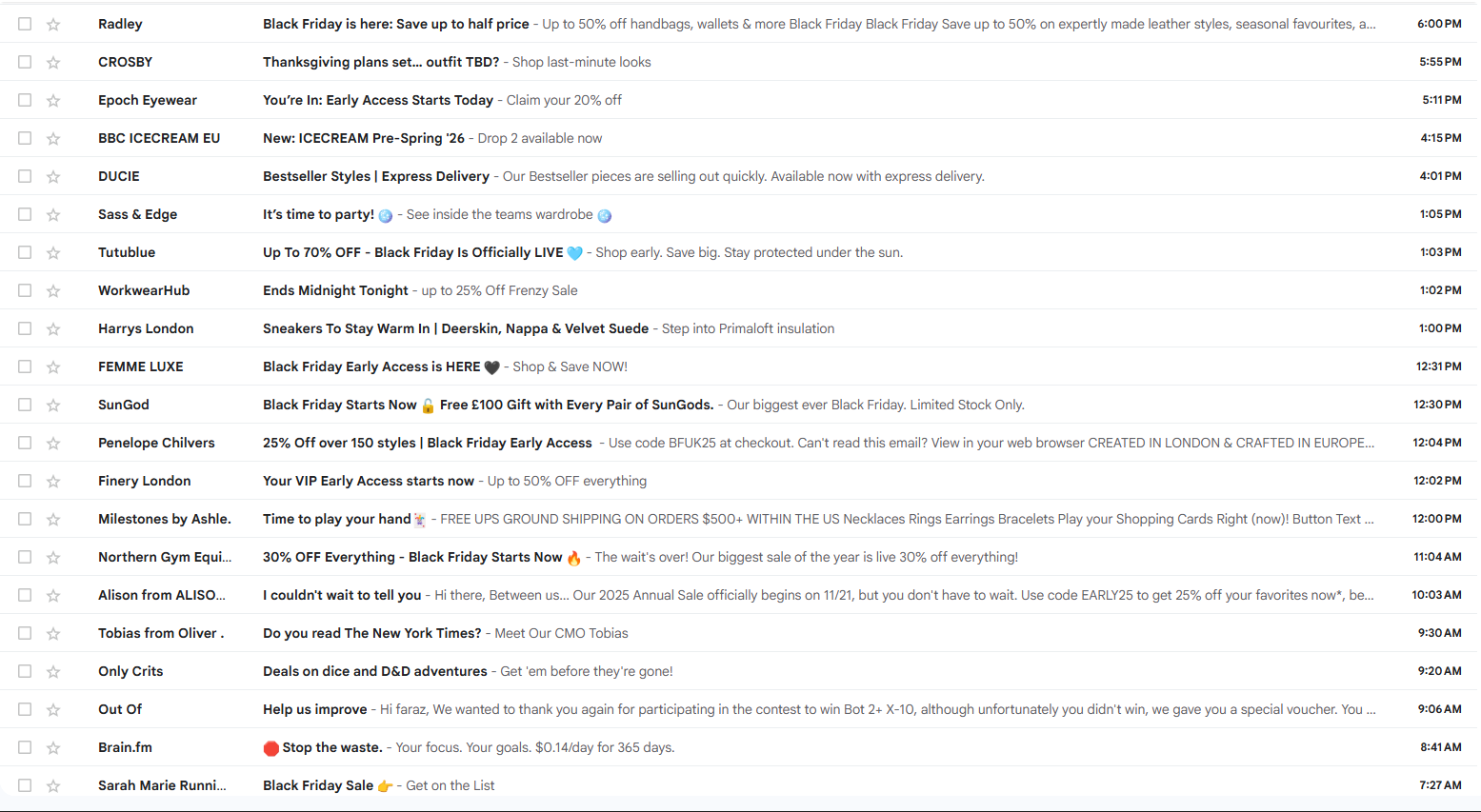Drive sales on autopilot with ecommerce-focused features
See FeaturesBlack Friday and Cyber Monday are the highest traffic and revenue events of the year for ecommerce brands. Yet, as an email marketing agency working with ecommerce brands year-round, we see the same patterns play out every single BFCM season.
Competition is intense, and customer attention is split because inboxes move faster than at any other time of the year. But if you workshop your strategy before the chaos hits, your BFCM revenue has a much better shot at reaching its real potential.
Success during BFCM is rarely about last-minute tactics. It comes from tightening your strategy long before the rush begins. So let’s look at the most common pitfalls — and how to avoid them.
1. Waiting too long to test your offer
The biggest mistake brands make is waiting until mid-November to finalize strategy. By that time, there is no room left to experiment with discount levels, bundles, or messaging angles.
By testing early, in September or October, not only do we learn what customers respond to and ignore. We also learn whether tiered discounts, gifts, or bundles drive the most revenue. Entering November with real data rather than assumptions gives us a major advantage.
Here’s an example from a jewelry brand we worked with,
We tested a simple 10% Halloween discount against a “15% off over €100 purchases” offer. The 10% discount produced 40 sales, while the other offer produced only 5.
If we had skipped testing, the brand would’ve gone into BFCM with the wrong offer and left serious revenue on the table. Instead, we recommended a straight 15% discount with no AOV limit, because we’d already seen how their audience behaved.
2. Holding back on frequency because you’re afraid of “annoying” people
During the peak BFCM period, brands often stick to their normal sending frequency because they don’t want to overwhelm subscribers. Meanwhile, competitors are sending two or three emails a day.
When everyone is emailing at once, sending “normal” volume means disappearing.
The best performing brands maintain visibility with more reminders, more clarity, and more touchpoints — not less.
Below is a picture of my inbox. As you can see, it’s not as much about being loud, but rather not being forgotten.

3. Skipping hype and forgetting to build a VIP list
Many brands treat BFCM like any other sale. But where are your teasers? Where’s the early access and the build-up of anticipation? No teasers.
It’s not “another promotion.” Your customers expect a build-up, and they want to know something big is coming.

Teaser emails, sneak peeks, early-bird signups — these small moves create urgency before the sale even begins. And if you build a dedicated VIP list, you’re giving your most engaged customers a reason to convert first.
4. Treating BFCM as a one-email event
As mentioned above, BFCM needs a structured series of emails, not a single launch email. When brands treat it like any other sale, they miss out on maximizing sales from the biggest event of the year.
A strong BFCM setup moves in stages:
- Teasers
- Early access
- Main announcement
- Follow-ups
- Last-chance reminders
- Transition into Cyber Monday
This creates a sense of progression and keeps the audience engaged throughout the event.
5. Only emailing on Black Friday
Even the best BFCM week won’t save a brand that only emails once a year.
If the audience hasn’t heard from you since the last BFCM, they’re not warmed up, not familiar with your tone, and not primed to buy. Consistency throughout the year matters.
A simple rhythm of two emails per week — promotional, educational, or engagement — keeps the relationship alive. BFCM works best when it’s built on familiarity.
6. Not updating pre-purchase automations for BFCM
When a large portion of seasonal traffic enters during the BFCM period, brands lose a major opportunity when the pre-purchase automations, like Welcome series, Cart or Browse abandonment workflows, aren’t updated with BFCM in mind.
Even small changes, such as adding a promo bar, updating banners, or mentioning the sale inside the subject line, can increase conversions.
Pre-purchase automations work around the clock, which means they should reflect the most important sale of the year.
These minor changes don’t take much, and even if you save these changes and reuse them every year, you will still get more revenue. There’s no need to re-invent the wheel.
7. Treating Cyber Monday as an afterthought
Cyber Monday is still a high-revenue day, but many brands treat it as an afterthought.
A fresh subject line, slightly different angle, or stronger urgency can help recapture customers who didn’t buy during Black Friday.
We typically keep the same offer but refresh the positioning to maintain momentum.
8. Skipping countdown timers and urgency signals
Countdown timers work. Period.
We consistently see higher click-through and conversion rates when a clear timer appears in emails or on landing pages. BFCM is not the time when “I’ll buy later” leads to a sale.
A visible deadline helps customers understand the offer is real, limited, and ending soon.
Wrap up
Brands that capitalize on BFCM aren’t relying on last-minute decisions or a single discount. Their success comes from the decisions made weeks earlier — testing your offer, warming up your list, tightening your flows, and creating a plan you can execute calmly once the week arrives.
To improve your performance this year, use data instead of assumptions, stay visible when inboxes get chaotic, and remove as much friction as possible from the path to purchase.
And of course, avoid the common pitfalls, prepare earlier than you think you need to, and treat BFCM like the high-stakes moment it is. Do that, and your results will reflect it.
Author bio

Haseeb Ahmed is an email marketer with over 3 years of experience, scaling ecommerce brands through strategic email marketing at Goals & Beyond.
TABLE OF CONTENTS
TABLE OF CONTENTS


No fluff, no spam, no corporate filler. Just a friendly letter, twice a month.

 OFFER
OFFER







